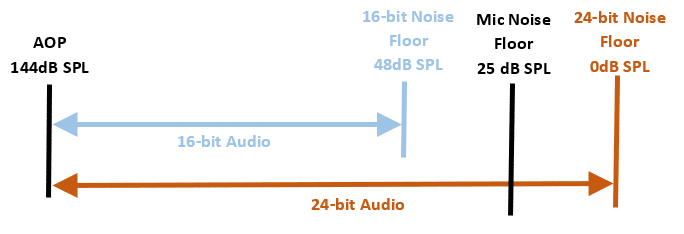Traditional full-duplex voice communications systems are designed with 12-bit to 16-bit audio codecs. 16-bit audio provides 96dB of dynamic range. This is more than sufficient for telephony grade applications. Acoustic echo cancellation (AEC) requires implementation of multiplication intensive loops for FIR filtering and adaptive filtering updates. 16-bit data types are preferred for performing audio processing on low power fixed point embedded DSPs, as they can efficiently implement 16 by 16 multiple and accumulates.
With the increased importance of audio conferencing in modern work environments, it is desirable to achieve the best audio quality possible. Low-cost digital MEMS microphones have improved to point where the noise floor and acoustic overload point (AOP) have a dynamic range greater than 96dB. Thus, more bits can be used to represent the audio signal. 24-bit audio provides 144dB of dynamic range. Adding bits and dynamic range improves the audio quality by lowering the noise floor and increasing the SNR of the audio signal. 
Can these extra bits be used efficiently on fixed point DSPs? For VOCAL’s AEC software, the answer is yes. The adaptive filter of VOCAL’s AEC is implemented in the subband domain where implementing efficient fixed point arithmetic on audio signals with expanded dynamic range is possible. This AEC implementation provides the ability to use high fidelity audio on low power fixed point DSPs.
VOCAL Technologies offers variety of off-the-shelf and custom designed solutions for echo cancellation. VOCAL offers a variant to its AEC that supports a 32-bit interface with the 24-bit audio stored in the most significant bits.